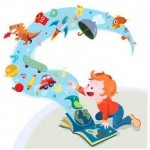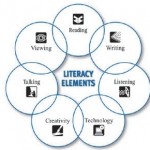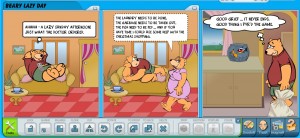‘Spell with Flikr’ is an interesting application which allows a little bit of whimsy into a world dominated by uniformity of size, shape and colour. How many times have I tried to make a handout more interesting by changing the font style, size and colour, only to be disappointed in my efforts? Too many to tell you and still maintain my dignity.
Here I’ve decided to give up the notion that all things must be the same for the message to be clear and concise. The unique mosaic like image that is produced sends an overall message while each component (letter/image) is also a stand-alone piece that can be observed separately. The attempt for me is to allow ‘difference’ to work as one to produce a coherent ‘common’ message.
This application allows one to be creative but still ultimately in control at the same time as each letter/image can be altered individually by clicking on it. It seems that ‘Spell with Flikr’ solidifies the notions of the breakout of the visual that we explored earlier. Here the visual and the textual are merged and morphed into one.
Potential drawbacks on the other hand are that those with firm feelings of uniformity and control may spend a great deal of time altering each image to fit a preconceived vision of the finished product. Such efforts miss the intent of the overall application and limit the creativity which makes this unique application interesting.











Making Connections – Finding Balance & Meaning In Text Driven Societies
Hi All,
In order to make this a useful reflection and connection piece, I will try to pull out some key themes that resinated with me during this course and make an important connection between the ubiquitous nature of text and it’s impact on us.
Orality
Literacy/Writing
New Media
How have various communication technologies modified reading and writing practices situated in education?
Finding Balance And An Ethical Lens in Text Based Societies
We are constantly surround by and engaged in text technologies and new media environments. Because of the omnipresent nature of current media and text technologies we can sometimes feel overwhelmed by the constant “need” to be connected to people and communities across the world. I believe that we miss or don’t spend enough time considering the impact the fast paced remediation of text has on the individual. With this in mind I would like to pose the following questions:
These 4 Youtube videos help focus me as I try to ethically manoeuvre throughout the multifaceted world of new media technologies.
Tim Cook – Collaboration
https://www.youtube.com/watch?v=EZPYLZ7I6gs
Simon Sinek – First “Why” Then Trust
https://www.youtube.com/watch?v=4VdO7LuoBzM
Graham Hill – Less Stuff More Happiness
https://www.youtube.com/watch?v=L8YJtvHGeUU
Nigel Marsh – Life Work Balance
https://www.youtube.com/watch?v=SXM7MpoVAD0
Best
Steve